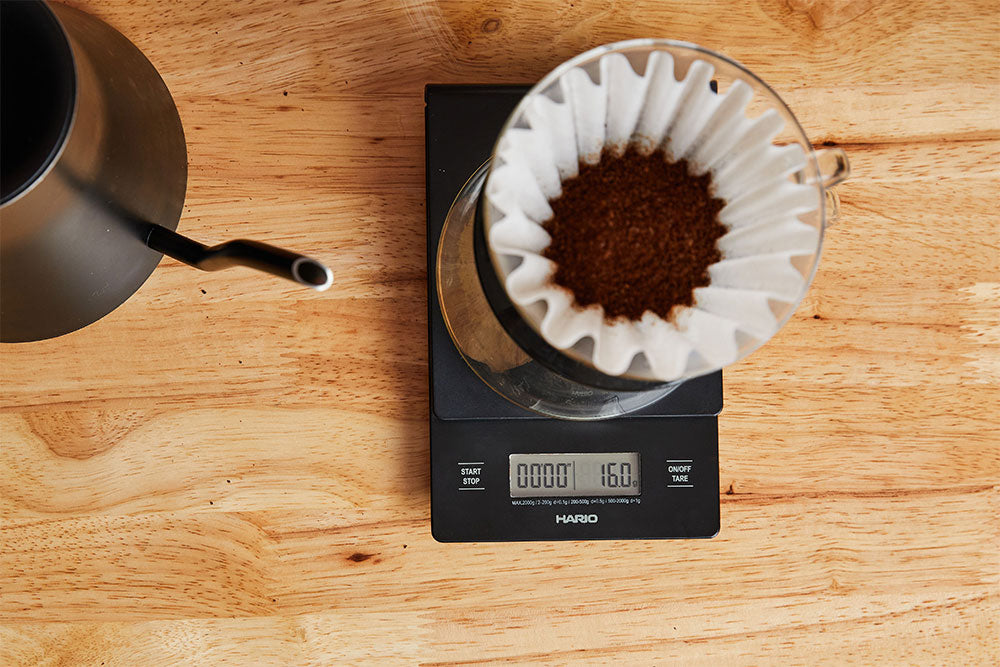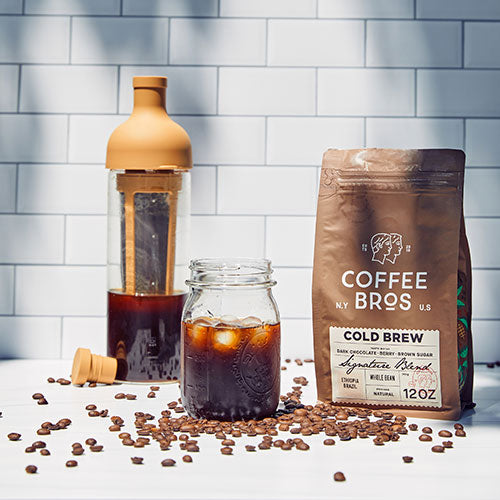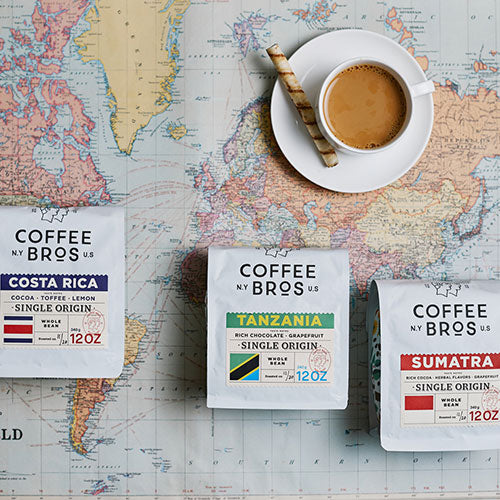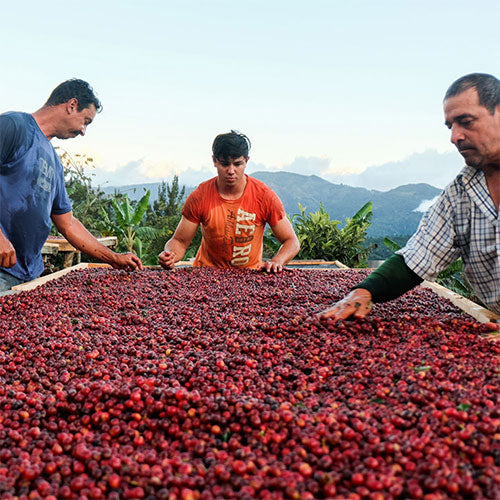Coffee Brew Ratios: Coffee to Water Ratios Explained
Introduction
Coffee brew ratios, sometimes called coffee-to-water ratios, can be confusing and leave most guessing the best ratio for their morning beverage. We wanted to break down the topic into bite-sized chunks so you can better understand what a 1:17 brew ratio is, how to execute it, and how to adjust it to fit your taste buds! We will also touch on the different brew ratios for espresso as they sit outside the range of their non-pressurized counterparts. There is also a concept of espresso-to-milk ratios that we will briefly touch on for those interested in crafting the perfect traditional milk-based espresso drink.
Grab a cup of perfectly proportioned coffee and enjoy the read!
Need to know the answer now; use our Coffee to Water Calculator, which will give you the best coffee-to-water ratios for all brew devices and taste preferences.
Table of Contents
- What are coffee to water ratios or brew ratios (non espresso)
-
What are espresso brew ratios
- Ristretto
- Normale
- Lungo
- What is the Golden Brew Ratio
- What are the standard coffee brew ratios
- What else impacts your coffee brew besides coffee to water ratios
- What tools do you need for the perfect coffee brew ratio
-
Coffee to water ratios for different brew types
- Pour-over coffee to water ratio
- Drip coffee machine coffee to water ratio
- French press coffee to water ratio
- Cold brew coffee to water ratio
- AeroPress coffee to water ratio
Coffee Subscription Deal
Subscribe to Coffee Bros. coffee for 25% off when using code "FTSUB25" at checkout
What are coffee to water ratios?
Simply put, coffee-to-water ratios or brewing ratios are the number of coffee grounds versus the water used during brewing.
Coffee-to-water ratios always start with the amount of ground coffee in grams, say 20 grams, versus the amount of water in grams, 300 grams; this would be a 1:15 ratio (20 divided by 300 = 15).
No one likes doing math early in the morning, so we created a coffee-to-water ratio calculator that can get you the answer quickly but read on to learn more about brew ratios.
The Specialty Coffee Association recommends a 1:18 coffee-to-water ratio as their Golden Cup Standard for many brewing methods like pour-over, French Press, Chemex, and Autodrip. The Golden Cup Standard does not work for pressurized brewing like espresso and the recommended brew ratios there and drastically different; more on that below.
What are espresso brew ratos?
We like to define espresso brew ratios in their own category as they sit outside the range of your typical drip or immersion brew ratios. Espresso brew ratios are the same as coffee brew ratios, the ratio of coffee grounds to grams versus the amount of water used.
For example, a double espresso calls for a 1:2 ratio, meaning that for every 1 gram of ground coffee in your espresso portafilter, you aim for 2 grams of espresso in your cup. A standard double espresso recipe would call for 19 grams of finely ground coffee in your portafilter, yielding 38 grams of espresso in your cup and typically within 30 – 35 seconds.
Traditional espresso recipes or ratios fall in the 1:1 to the 1:4 ratio and have unique names as defined below.
Ristretto espresso brew ratio: A ristretto shot, also known as a restricted or short shot, is characterized by a brew ratio between 1:1 and 1:1.5.
You can pull single or double ristretto shots, and they are simply shots that are stopped early in the brewing process to reach the goal of 1 gram of coffee to 1 gram of liquid.
A 1:1 ristretto shot may look like 14 grams of coffee in a single basket, yielding 14 grams of espresso liquid in your cup. Ristretto shots are darker, bold, and richer than the other types of espresso shots due to the tight coffee-to-water ratios.
Normale espresso brew ratio: A normale shot, also known as a standard shot, typically features a brew ratio between 1:2 and 1:3. A higher ratio can result in a clearer espresso and a higher extraction percentage.
A typical normale shot may look like 18 grams of coffee in a double basket, yielding 36 grams of espresso liquid within 30 seconds.
Lungo espresso brew ratio: A lungo is a larger espresso shot pulled at a higher brew ratio, resulting in a cup twice the size of a regular espresso shot. The ratio of coffee to water in a lungo is typically between 1:3 and or 1:4, which may vary depending on the barista or home brewer's taste preference.
A lungo shot is typically used when the barista wants to increase the drink’s clarity. Lungo shots work very well for light-roasted coffees and complex single origins.
A typical lungo shot at a 1:4 ratio may look like 18 grams of coffee into your portafilter, yielding 72 grams of espresso liquid in your cup.
What is the Golden Brew Ratio?
Golden Cup Standard:
The Golden Cup Standard is an excellent baseline for any brewing method, including pour-overs. The standard recommends a coffee-to-water ratio of 1:17 to 1:18, meaning you would use 17 grams of water for every 1 gram of coffee grounds.
Some may find this ratio to be a bit weak, resulting in a slightly watery cup of coffee. The Golden Cup Standard is particularly well-suited to those seeking clarity in their coffee, light roast enthusiasts, or those who prefer single-origin coffee.
Starting with the Golden Cup Standard is an excellent idea, even though it is a bit mild. You can then gradually increase the coffee-to-water ratio to achieve a stronger brew.
What are some standard coffee brew ratios?
Let’s talk about great places to start when thinking about brew ratios. First, understand that the larger the gap between your coffee and water ratio, the higher the clarity in your cup will be and the less robust it will be.
Most prefer moving toward the Golden Cup Standard 1:18 when drinking light-roasted coffee or highly complex single-origin coffees. The same holds true when you are brewing espresso. Most shy away from brewing light-roasted espresso as the standard ratios typically result in a super bright and sour cup of coffee. When extending the ratio to a 1:4 (lungo) you can get some extremely nice results brewing a lightly roasted coffee for espresso.
The Golden Cup Standard of 1:18 is also what most coffee professionals use when evaluating coffees or when “cupping” coffee. The larger ratio is ideal for evaluating coffee as the ratio is not falsely influencing your taste perceptions by being overpowering or bold. Again, the 1:18 ratio is great for clarity but may not be your preferred ratio of choice.
Here are some good starting points:
Non pressurized brewing (drip and immersion)
Mild (1:18)
The mildest of recommendations comes in at 1 gram of coffee for every 18 grams of water. This is the Golden Cup Standard recommended by the Specialty Coffee Association and is a great starting point for most brewing methods. We recommend this as a good starting point for most drip coffees like pour-over, Chemex, and drip machines.
The 1:18 ratio will give you with a clean, crisp, cup with high clarity. As you tighten the ratio to have less water to coffee, you will increase body and richness in the cup. This 1:18 ratio is excellent for light-roasted coffees or complex single-origin coffee. The equivalent of a 1:18 ratio on the espresso side would be a lungo or a 1:3 – 1:4 coffee-to-water ratio.
Average (1:17)
We like the 1:17 ratio, which is slightly more robust than the Golden Cup Standard but still provides a ton of clarity in your cup. We often see a 1:17 or a 1:16 as a recommended starting point within most coffee brew recipes. A 1:17 ratio would be 1 gram of coffee for every 17 grams of water.
Strong (1:15)
Strong and robust recommendations are for those looking to increase the body in their cup. We find that medium to darker roasted coffees work extremely well at these ratios if you are looking for a cup with a heavy rich mouthfeel. For a strong 1:15 ratio coffee brew use 1 gram of coffee for every 15 grams of water.
Robust (1:13)
The robust option uses a lot of coffee, and it really alters the cup as you are approaching coffee concentrate levels! We brew at these levels quite often as we enjoy a rich cup of coffee during our early morning coffee roasting sessions. We use our Medium Roast, coarsely grind between 26 – 27 grams of coffee, and brew 340 grams or 12-ounce pour-over, which we split into two cups of 6 ounces. This coffee is rich, bold, and heavily altered due to the amount of coffee to water used. Brew a 1:13 and 1:18 pour-over side-by-side to understand better how adding more coffee influences your final brew.
Concentrate (1:6 - 1:8)
We included the “concentrate” ratio for those looking to brew Cold Brew coffee. Cold brew is typically brewed in concentrate form, and then add water or milk is added post-brew. The standard cold brew concentrate falls between a ratio of 1:6 and 1:8 coffee grounds to water. The coffee is immersed in the water for 16 – 24 hours, and then add water or milk is added to make the final drink.
What else impacts the taste of coffee?
While your brew ratio plays a large part in how your coffee tastes, there are several other factors that you need to be aware of when brewing coffee.
Time:
The time corresponds to the time it takes to reach your recipe’s end weight. The shorter your brew is in comparison to a recipe’s ideal time, the more under-extracted, thin, and sour it might taste. The same is true for a brew that goes well beyond the ideal end time. You might find coffees that brew too long to be over-extracted, bitter, and intense. The over-extraction can be further exacerbated when you are working with a strong to robust coffee-to-water ratio so be careful here.
Grind Size: The grind size matters across all brewing methods and will impact your coffee’s total brewing time. Finer ground coffee will brew much slower than one that is ground coarser. Your grind size will correlate to how fast the water flows through the bed of coffee grinds and directly influence your extraction.
Coffee that is ground too fine may extend your brew beyond your intended brew time and create a drink that is over-extracted. The opposite would happen if you ground too coarse leaving you with a thin, under-extracted, and sometimes sour brew.
We often shoot for a medium coarse ground coffee when brewing for pour-over, but slight adjustments may be needed to hit your target time.
Temperature:
Temperature is sometimes the Cinderella of brewing parameters and is often tossed aside as unimportant.
Like all other inputs when brewing coffee, the temperature can also have a massive impact on your brew quality. Using the wrong temperature can cause extremely acidic and sour tasting cups of coffee or the opposite toward extremely bitter and harsh.
Regular coffee machines can rarely brew beyond 200 degrees Fahrenheit which may be ideal for very dark roasts (which do better at brewing at lower temperatures) but does a disservice to those wanting to get the most out of lighter roasts. There are some machines that don’t allow you to adjust the temperature at all which will result in an inconsistent and lackluster cup of coffee each time you brew.
If you own a regular drip coffee machine, it may be best to avoid lighter roasts as they do the best brewing almost right off boil which automatic machines cannot replicate. The control of temperature and the ability to brew at any temperature you deem appropriate for that coffee is what makes the pour-over a superior brewing method to any drip machine you can buy.
Coffee Processing Method or Roast Level:
The coffee you purchase plays a major role in how your final brew will taste. Get familiar with the different processing methods (natural, washed, honeyed) and how they impact the taste. A more common factor that most are familiar with is roast level and how a lighter-roasted coffee may taste versus a darker-roasted one.
Water:
Water represents 99% of the liquid in your cup so brewing with a good spring water makes all the difference.
What tools do you need for the perfect coffee brew?
To properly measure your coffee-to-water ratios all you really need is a scale that can report out in grams or ounces. When thinking through the other factors that impact the final taste in your cup, a high-quality grinder, kettle with temperature readings, and a scale with time and weight measurements would be needed.
Scale
To follow a recipe precisely, you will require a scale that can report measurements in grams, ounces, and preferably time as well. This is an area where you can save money and need not splurge on the purchase. You can purchase a scale with the essentials for under $30.00 or go for a high-end one with built-in brew guides.
Kettle
Precision is key when it comes to pour-over brewing so your standard widemouthed kettle will not work for this brewing application.
The recommended kettle for pour-over brewing is the gooseneck kettle which helps with precision pouring and consistent flow rates. It is much easier to control where your water is going and how fast it is flowing with a gooseneck kettle versus the alternative widemouthed version. As we noted earlier in the article, timing is one of the three key factors for the perfect brew and a gooseneck kettle will keep your timing under your control.
You do not need to go fancy here but there are options for electric gooseneck kettles upward of $150.00. The perk of an electric kettle is how quickly it heats up as well as its ability to hold any temperature you set. If you want to nail your temperature exactly each time, an electric kettle like the Fellow Stagg is ideal. Otherwise, you can find rather cheap gooseneck kettles with built-in thermometers on Amazon for under $30.00.
Grinder
If you're new to the world of coffee, a reliable conical burr grinder such as the Baratza Encore, which costs less than $170.00, would be a good starting point. This is the same grinder that many coffee professionals began with before upgrading to more advanced grinders with better burr sets for more consistent grinds.
The question of when to invest in a grinder ultimately comes down to your personal choice. However, we strongly recommend doing so as we believe it is a crucial step in achieving consistently exceptional coffee.
Coffee to water ratios for different brew types
Pour over brew ratio
We recommend three coffee-to-water ratios for a pour-over depending on whether you want a mild, average, or robust cup of coffee.
Mild: 1:18 or the SCA Golden Cup standard
Average: 1:16
Robust: 1:13
*Use our coffee calculator for the exact measures, and please note that all ratios are 1 gram of coffee to “x” grams of water.
French Press brew ratio
We recommend three coffee-to-water ratios for a French Press depending on whether you want a mild, average, or robust cup of coffee.
Mild: 1:18 or the SCA Golden Cup standard
Average: 1:15
Robust: 1:13
*Use our coffee calculator for the exact measures, and please note that all ratios are 1 gram of coffee to “x” grams of water.
Chemex brew ratio
We recommend three coffee-to-water ratios for a Chemex, depending on whether you want a mild, average, or robust cup of coffee.
Mild: 1:18 or the SCA Golden Cup standard
Average: 1:16
Robust: 1:13
*Use our coffee calculator for the exact measures, and please note that all ratios are 1 gram of coffee to “x” grams of water.
Auto drip brew ratio
We recommend three coffee-to-water ratios for an Autodrip, depending on whether you want a mild, average, or robust cup of coffee.
Mild: 1:18 or the SCA Golden Cup standard
Average: 1:17
Robust: 1:13
*Use our coffee calculator for the exact measures, and please note that all ratios are 1 gram of coffee to “x” grams of water.
Moka Pot brew ratio
We recommend three coffee-to-water ratios for a Moka Pot, depending on whether you want a mild, average, or robust cup of coffee.
Mild: 1:9
Average: 1:8
Robust: 1:6
*Use our coffee calculator for the exact measures, and please note that all ratios are 1 gram of coffee to “x” grams of water.




